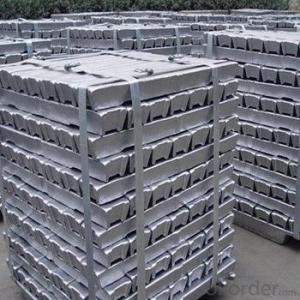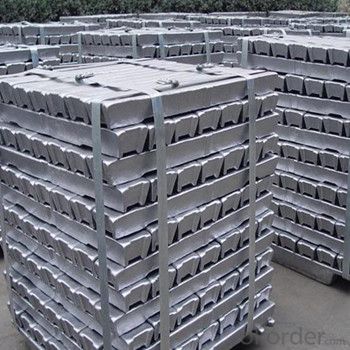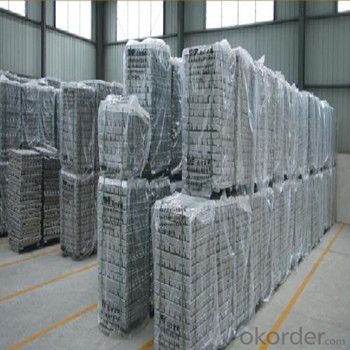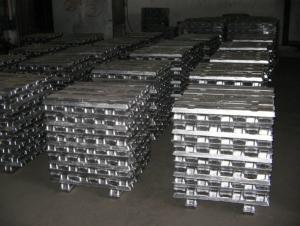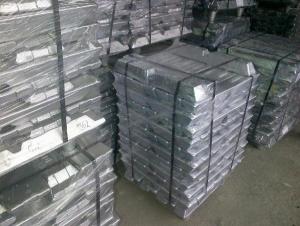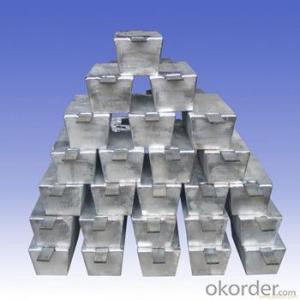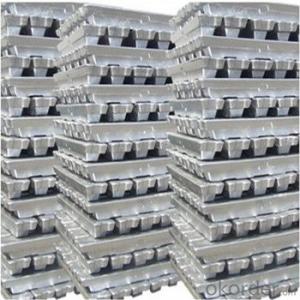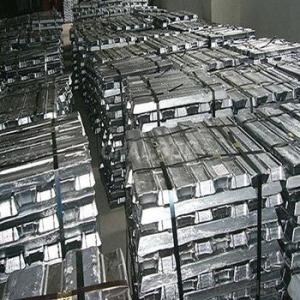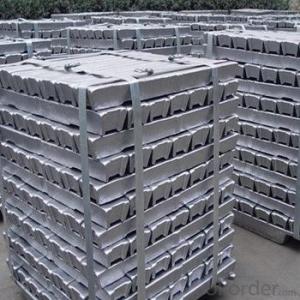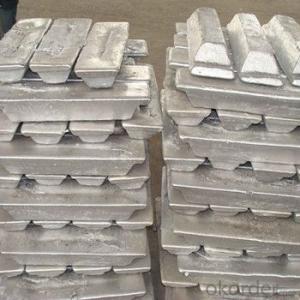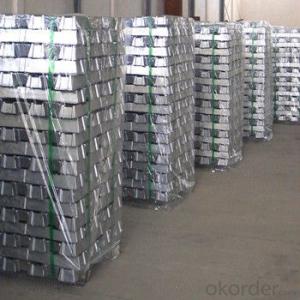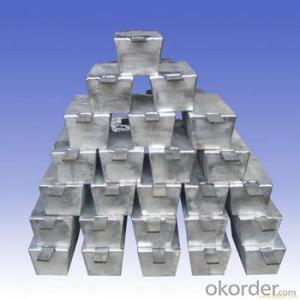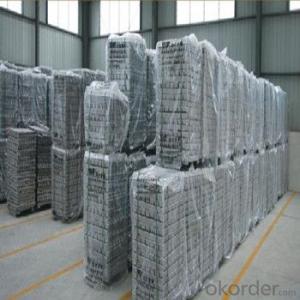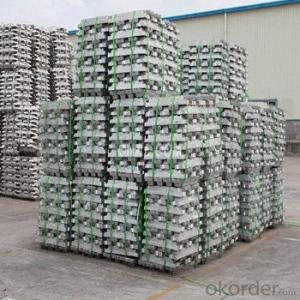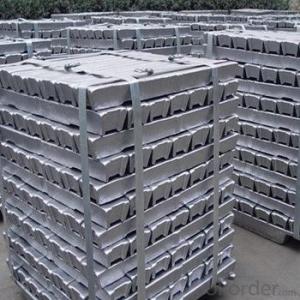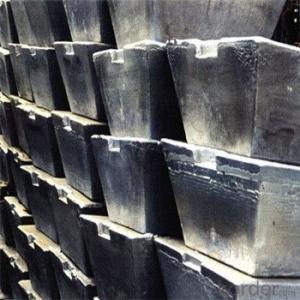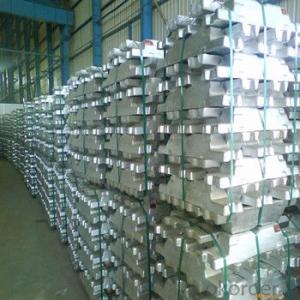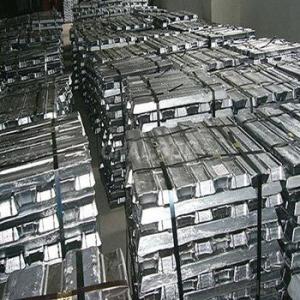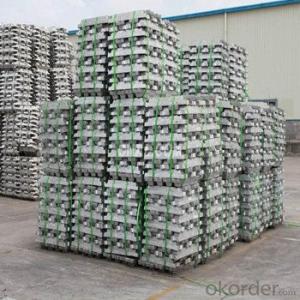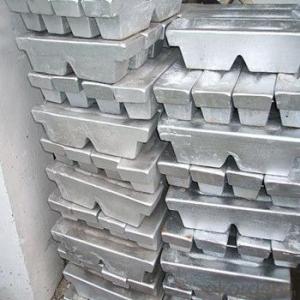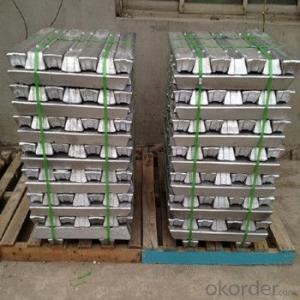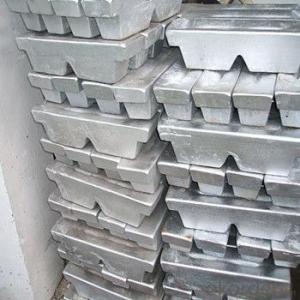Aluminum Pig/Ingot With Grades And Purity For Choice
- Loading Port:
- China main port
- Payment Terms:
- TT OR LC
- Min Order Qty:
- 1000 m.t.
- Supply Capability:
- 100000 m.t./month
OKorder Service Pledge
OKorder Financial Service
You Might Also Like
Pure Aluminum Pig/Ingot Used for Industry
1.Structure of Aluminum Pig/Ingot
A material that has been cast into a shape in order to be transported and processed easier than in an unprocessed form. An ingot is typically rectangular in shape, which allows it to be stacked. Ingots are most commonly associated with metals, with ingots of gold held in the vaults of banks and brokerages being popular images.
Aluminum Ingot is with the AL as the main chemical composition.Aluminum Ingot is used for industry,such as automobile,pinning and weaving,electron broadly and so on. Aluminum Ingot has the following advantages: easy control and operation, fast melting.
2.Main Features of the Aluminum Pig/Ingot
•High Purity
•Easy control and operation
•High strength
•Fast melting
•Competitive price
•Best Service
3.Aluminum Pig/Ingot Images
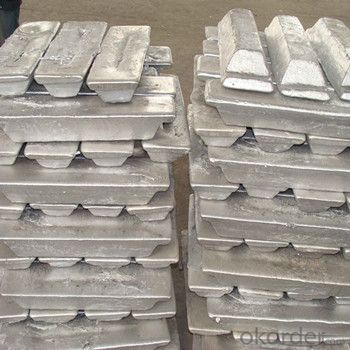
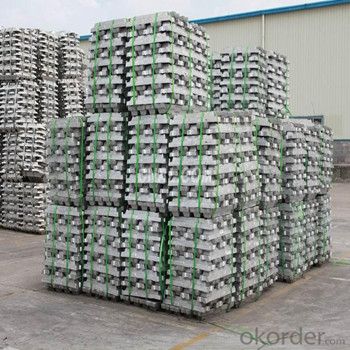
4.Aluminum Pig/Ingot Specification
Grade | Chemical Composition % | |||||||||
Al≥ | impurities ≤ | |||||||||
Si | Fe | Cu | Ga | Mg | Zn | Mn | others | Sum | ||
Al99.9 | 99.90 | 0.50 | 0.07 | 0.005 | 0.02 | 0.01 | 0.025 | - | 0.010 | 0.10 |
Al99.85 | 99.85 | 0.80 | 0.12 | 0.005 | 0.03 | 0.02 | 0.030 | - | 0.015 | 0.15 |
Al99.7 | 99.70 | 0.10 | 0.20 | 0.010 | 0.03 | 0.02 | 0.030 | - | 0.030 | 0.30 |
Al99.6 | 99.60 | 0.16 | 0.25 | 0.010 | 0.03 | 0.03 | 0.030 | - | 0.030 | 0.40 |
Al99.5 | 99.50 | 0.22 | 0.30 | 0.020 | 0.03 | 0.05 | 0.050 | - | 0.030 | 0.50 |
Al99.00 | 99.00 | 0.42 | 0.50 | 0.020 | 0.03 | 0.05 | 0.050 | - | 0.050 | 1.00 |
5.FAQ of Aluminum Pig/Ingot
We have organized several common questions for our clients,may help you sincerely:
①How about your company?
A professional factory which foucs on producing the aluminum pig,can meet customers' requiement to the quality and grade.The quality also have been accepted by customer.Already got the good reputation among the customers.It have gotten lot of much experience.The facrtory has the professional Technical Worker and the advanced equipments for production.Beside,it has the profesional teams to operate the whole proess for exporting.OEM service is availble and welcome.The items have beedn exported around the world,and have been acceptable among the customers,and have gotten the good reputation already.No matter from the quality,price and service,can be guaranteed for the cusgtomers.High purity and diffent grade are available.
②How to guarantee the quality of the products?
We have established the international advanced quality management system,every link from raw material to final product we have strict quality test;We resolutely put an end to unqualified products flowing into the market. At the same time, we will provide necessary follow-up service assurance.
③How long can we receive the prod rking days, We will arrange the factory delivery as soon as possible. The pecific time of receiving is related to the state and position of customers.Commonly 7 to 10 working days can be served.
- Q: What are the different coating processes for aluminum ingots?
- There are several different coating processes for aluminum ingots, including anodizing, powder coating, electroplating, and chemical conversion coating.
- Q: What kind of aluminum consumption does the furnace compare with natural gas?
- Oil burning more intense flame, smelting time will be much shorter than natural gas, this is the car after the gas, power is much better than gasoline. The answer is obvious: the aluminum loss of gas will be greater.
- Q: How much does it cost to process the aluminum ingots into T5-6063 models? Now, what about costing the aluminum ingot or the aluminum bar?
- 6063 is the alloy brand, T5 by the high temperature forming process cooling, and then the artificial aging stateThe utility model is suitable for artificial aging products after being cooled by the high temperature forming process without being cold processed (which can be straightened and straightened without affecting the mechanical performance limit)
- Q: What are the advantages of using aluminum ingots in the production of aircraft structures?
- There are several advantages of using aluminum ingots in the production of aircraft structures. Firstly, aluminum is known for its lightweight properties. This is crucial in the aerospace industry as it helps reduce the overall weight of the aircraft, leading to improved fuel efficiency and lower operating costs. The use of aluminum ingots allows manufacturers to create lightweight yet strong structures, enabling aircraft to carry more payload or fly longer distances. Secondly, aluminum has excellent corrosion resistance. Aircraft are exposed to various environmental factors such as moisture, humidity, and temperature fluctuations. Aluminum's natural corrosion resistance helps protect the aircraft's structure from degradation over time, ensuring durability and longevity. Additionally, aluminum ingots offer high strength-to-weight ratio. This means that even though aluminum is lighter than most metals, it still possesses remarkable strength. This property is crucial in aircraft structures, as it allows engineers to design components that can withstand the stresses and forces experienced during flight, ensuring the safety of passengers and crew. Moreover, aluminum is highly malleable and can be easily formed into complex shapes. This flexibility in manufacturing allows for intricate designs and precise engineering, enabling the production of aerodynamically efficient and structurally sound aircraft structures. It also simplifies the assembly process, reducing production time and costs. Furthermore, aluminum is a widely available and cost-effective material. Its abundance makes it easily accessible for manufacturers, ensuring a steady supply chain. Additionally, its cost-effectiveness allows for more affordable aircraft production, making air travel more accessible to a larger population. In conclusion, the advantages of using aluminum ingots in aircraft structures include lightweight properties, corrosion resistance, high strength-to-weight ratio, malleability, and cost-effectiveness. These characteristics make aluminum an ideal choice for aerospace manufacturers, contributing to the overall efficiency, safety, and affordability of aircraft production and operation.
- Q: Cost of material consumption of aluminium ingot
- Production cost refers to the total amount of material goods and remuneration paid by an enterprise to produce a certain amount of a commodity, that is, the C+V part in the composition of commodity value.
- Q: And aluminum liquid aluminum ingot related industries?
- The aluminum ingot process, also known as the metal aluminum process, is produced by directly passing the chlorine through the molten metal aluminum, which is directly contacted with each other. Aluminum production by AlCl3 has the advantages of simple process, less equipment, low investment unit. China's aluminum rich resources, the production of anhydrous aluminum chloride using basic aluminium ingot method.
- Q: Analysis of die casting aluminium ingot
- Non standard ingot ingredients as follows. (general non-standard zinc die-casting aluminum ingot will exceed the standard in 2-3, such as: Japan) ADC12Z (zinc below 3) silicon slightly low, other elements are close to ADC12. (GB aluminum standard available, here no longer).
- Q: Where to recycle aluminium ingot?
- Look at the yellow pages to find a large local purchasing station or to recover from related smelters. Aluminum extrusion plants should recycle ingots, and copper processing plants should recycle copper ingotsIn your near neighboring information network can see, and see not know 114
- Q: How are aluminum ingots used in the production of heat sinks?
- Heat sinks, which are crucial in dissipating heat generated by electronic devices, heavily rely on aluminum ingots. Aluminum is favored for heat sinks due to its exceptional thermal conductivity, lightweight properties, and cost-effectiveness. The initial step involves melting aluminum ingots and casting them into the desired shape and size of the heat sink. The ingots are heated to their melting point, typically around 660 degrees Celsius, and then poured into molds to create the initial shape. Once the heat sink shape is formed, it undergoes various machining processes such as milling, drilling, and cutting. These processes are necessary to generate the required fins and surface area for efficient heat dissipation. By increasing the surface area, the heat sink allows for better air circulation and heat transfer. After the initial shaping and machining, the heat sink often undergoes surface finishes or coatings. These treatments aim to enhance its thermal properties and protect it from corrosion. Examples of these finishes include anodizing, which forms a protective oxide layer, and electroplating, which improves appearance and durability. Once manufactured, the heat sink is typically attached to the electronic device using thermal interface materials like thermal paste or pads. These materials maximize the contact between the heat sink and the electronic component, ensuring efficient heat transfer. In summary, aluminum ingots are indispensable in heat sink production. They provide the necessary material for creating heat sinks with outstanding thermal conductivity, light weight, and cost-effectiveness. The use of aluminum ingots in heat sink production significantly improves the performance and reliability of electronic devices, effectively dissipating heat and preventing overheating.
- Q: How are aluminum ingots used in construction?
- Aluminum ingots are widely used in the construction industry for various applications due to their excellent properties and versatility. One common use of aluminum ingots in construction is for the manufacturing of structural components such as beams, columns, and trusses. The lightweight nature of aluminum makes it an ideal choice for these applications as it reduces the overall weight of the structure, leading to cost savings in transportation and installation. Additionally, aluminum ingots are used in the production of cladding systems, which are used to cover the exterior of buildings. These cladding systems provide aesthetic appeal, weather protection, and insulation to the structure. Aluminum's corrosion resistance and durability make it a preferred material for cladding, as it can withstand harsh weather conditions and maintain its appearance over an extended period. Moreover, aluminum ingots are employed in the fabrication of windows, doors, and curtain walls in construction projects. Aluminum frames offer strength and stability while providing a sleek and modern aesthetic. The material's corrosion resistance also ensures that these components remain durable and low-maintenance for a long time. Furthermore, aluminum ingots find applications in roofing systems. Aluminum roofs offer excellent resistance to corrosion, as well as being lightweight and durable. They are also highly reflective, which helps to reduce heat absorption and energy consumption, making them a sustainable choice for buildings. In conclusion, aluminum ingots play a crucial role in the construction industry. Their lightweight nature, corrosion resistance, and durability make them an excellent choice for structural components, cladding systems, windows, doors, curtain walls, and roofing systems. The use of aluminum ingots in construction not only enhances the overall aesthetics of the building but also contributes to its longevity, energy efficiency, and sustainability.
Send your message to us
Aluminum Pig/Ingot With Grades And Purity For Choice
- Loading Port:
- China main port
- Payment Terms:
- TT OR LC
- Min Order Qty:
- 1000 m.t.
- Supply Capability:
- 100000 m.t./month
OKorder Service Pledge
OKorder Financial Service
Similar products
Hot products
Hot Searches
Related keywords
